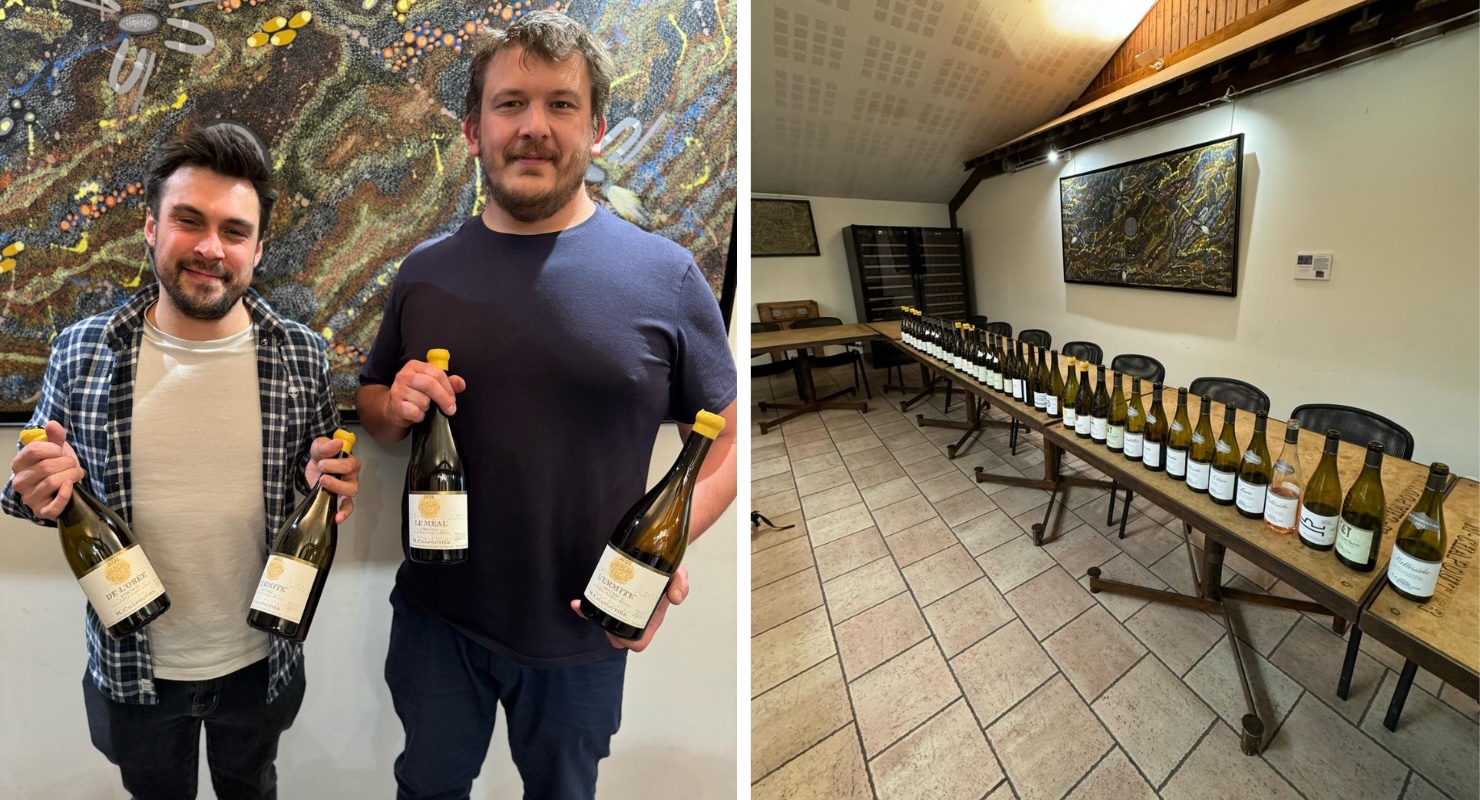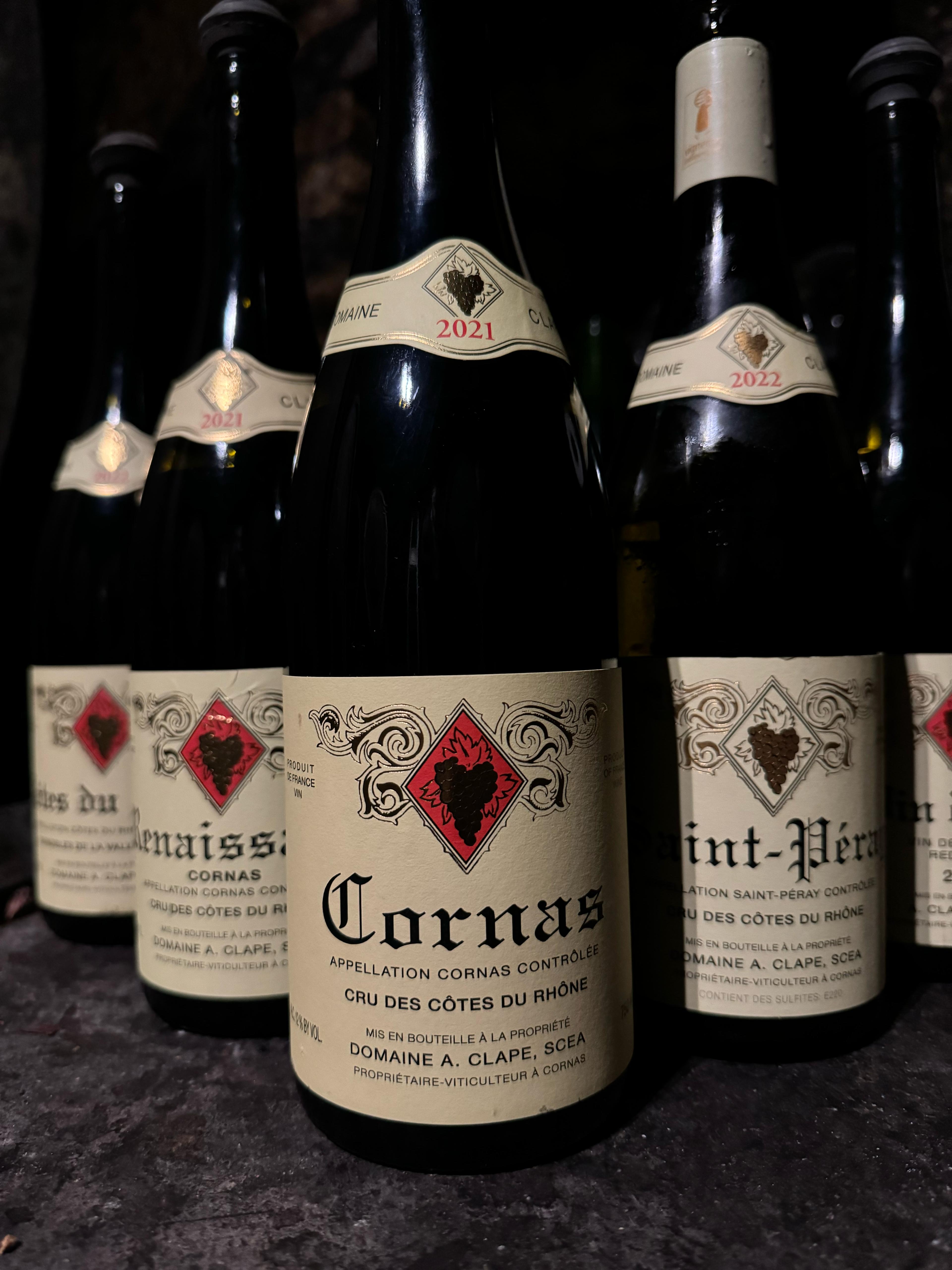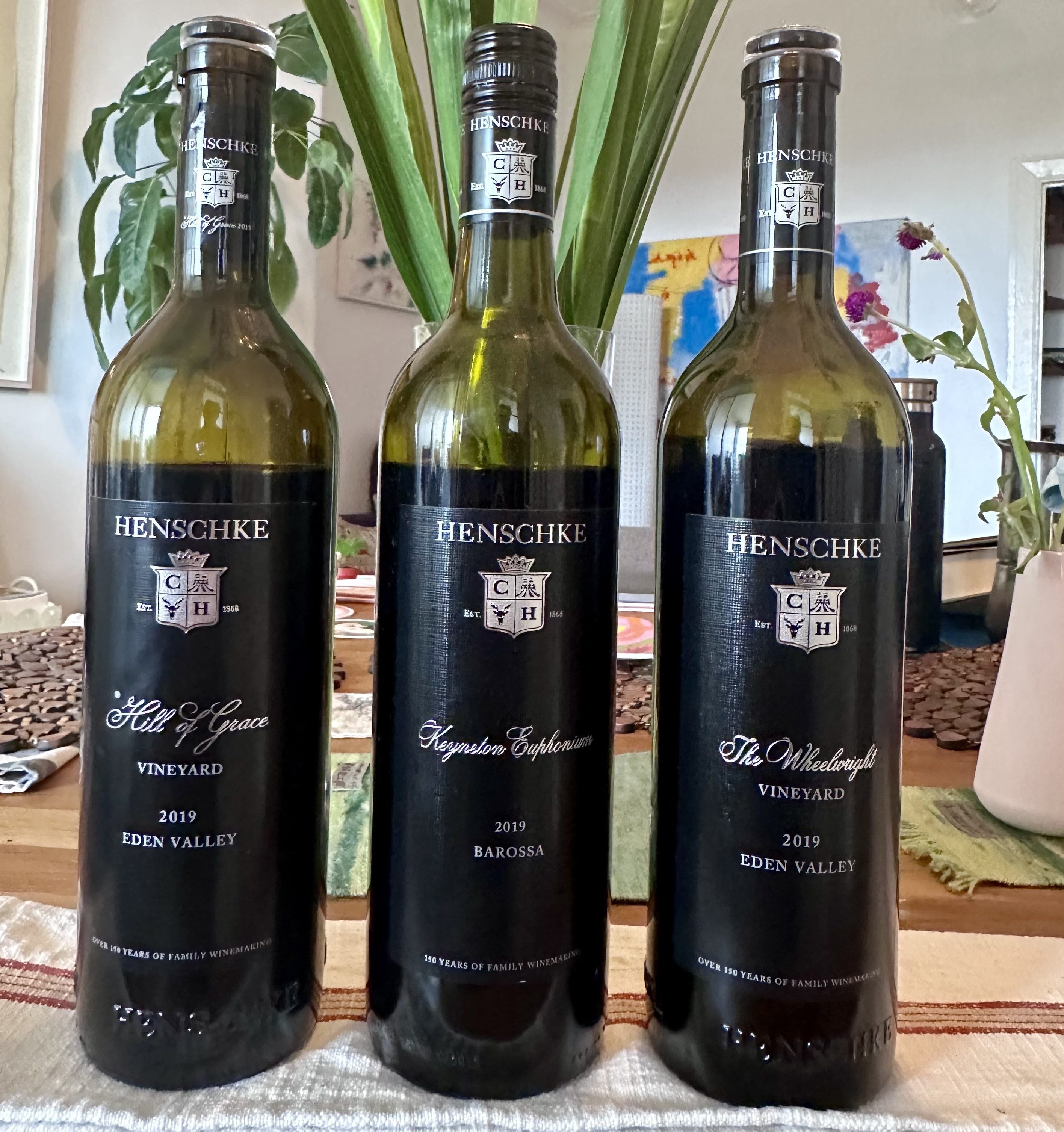
Senior Editor Stuart Pigott and Tasting Manager Kevin Davy continued their Rhone research trip in the region’s rocky northern region with a number of mind-blowing tastings. The most extraordinary of these was at M. Chapoutier in Tain l’Hermitage, because four wines earned perfect ratings of 100 points. That’s a truly exceptional situation, and it left Stuart and Kevin almost speechless. So what makes these wines so very special?
The syrah-based red wines of the Northern Rhone are always dark and structured, but they are also capable of great finesse and brilliance, particularly in a cooler vintage like 2021. In such years, winemakers often also struggle to avoid anything unripe or unclean (a moist fall like 2021 inevitably resulted in some rot), so hitting this bullseye is an enormous challenge. “When the harvest began we were quite worried, after the tough growing season, but then the wines turned out extremely well,” Maxime Chapoutier said.
The M. Chapoutier Ermitage Le Méal 2021 has a hypnotic nose of perfectly ripe wild blackberry, wild herbs and autumn bonfires. At once expansive and extremely dynamic on the palate, the minerals ignite a turbo-drive at the finish. In contrast, the M. Chapoutier Ermitage L’Ermite 2021 is like descending into a labyrinth of spices, with the perfect black fruit and violet aromas enrapturing. And the astonishing tannin structure give the finish explosive energy.
The whites are both pure Marsanne, with the M. Chapoutier Ermitage Blanc Le Méal 2021 a singularity of the Marsanne grape with an extraordinary interplay of smoky pineapple and stony character, then gigantic minerality at the totally focused, extremely long finish. The M. Chapoutier Ermitage Blanc L’Ermite 2021 is an essence of Mirabelle plums that starts quietly but expands and expands as it flows over your palate. How can such gigantic concentration be so perfectly balanced? When everything is spot-on in a vintage like 2021! It also helps that Le Meal and L’Ermite are among the stoniest sections of the Hill of Hermitage (dropping the H is an option).
Each of these masterpieces from the Hill of Hermitage is a selection parcellaire, meaning a wine made from grapes grown in a single parcel of vines. Of course, this means that quantities are more or less limited, so be prepared that these wines and the other selection parcellaire from M. Chapoutier might be hard to track down. They will also be expensive, since the combination of low yields and uncompromising hand-crafting on steep slopes demands that.
Nobody has been more extreme about single parcel bottling than Maxime Chapoutier and his father, Michel, but this is still an exception to the long-established path of blending wines from different sections of Hermitage. So there are two schools of Hermitage winemaking.


An incredible example of the latter of these is the Domaine Marc Sorrel Hermitage le Gréal 2022, which marries incredible concentration with every bit as much finesse. The forest berry aromas are right off the scale, the drive and energy at the finish must be tasted to be believed! This wine is a cuvée of the Le Meal and Les Greffieux sections of the hill. Stuart remembers tasting this producer’s wines over a decade ago and being impressed by the enormous concentration but finding the structure too massive. Since Guillaume Sorrel took over the winemaking a lot has changed, catapulting him into the first league of the Northern Rhone.
The JL Chave Hermitage 2021 is another breathtaking example of this with incredible refinement, floral elegance and silkiness. The very fresh and pristine finish dazzles with violets and white pepper. Of course, Chave has been a legend for decades, and the wines effortlessly live up to their reputation. Buying even a single bottle of this one will not be easy though due to the enormous demand, but there’s a lively secondary market.
Another producer that has taken the single-vineyard path is the house of Delas, and the Delas Hermitage Lieu Dit Ligne de Crête Les Grandes Vignes 2022 is a full-throttle Hermitage with notes of raw meat, smoke and licorice as well as stacks of wild blackberry fruit and plush tannins.
The move to this famous producer’s new winery was accompanied by a change in winemaking, with 80 percent of this wine being from whole cluster fermentation to gain freshness in the hot and dry year. And that strategy worked! More details about the recent vintages in our forthcoming report.


Cornas has the reputation of producing some of the darkest and most complex wines of the Northern Rhone, and 2020 is probably the greatest vintage to date for Domaine Colombo. The Domaine Colombo Cornas Vallon de L’Aigle 2020 has super-ripe elderberry fruit with great smoky complexity and is extremely concentrated and velvety with a super-long plush finish. The Domaine Colombo Ainsi Soit-Il 2020 has even more fruit and bitter chocolate and comes from the same altitude plot of old vines, but production is very limited.
Nobody in Cornas is more famous than Domaine A. Clape, and the Domaine A. Clape Cornas 2021 is a great classic, finely chiseled, pure and complex with the brightness and succulence of the vintage beautifully expressed, white pepper and violets cascading over the palate.
All of these wines are expensive and more or less difficult to find. However, if you need a great Northern Rhone syrah but don’t need a famous name, there are more modestly priced options like Domaine Vincent Paris in Cornas. The Domaine Vincent Paris Cornas La Geynale 2022 has the smoke and grilled meat character beautifully ripe syrah gives you in this appellation and is extremely dense with fine tannins with an energetic and velvet finish.
All of this excitement overshadows the famous appellation of Cote Rotie slightly. This is partly due to the way 2021 shined brighter in Hermitage, and partly because one top Cote Rotie producer, Stephane Ogier, bottles late. Stuart and Kevin loved his 2022 vintage wines that they tasted from barrel, but they are some months away from bottling and we don’t write notes for such unready wines. So watch this space!

HENSCHKE’S FRESH 2019s
Senior Editor Ned Goodwin MW recently returned from the more savory and structural tendencies of Italian wines to Australian exuberance of fruit. The first suite of wines he tasted upon his return were the new releases from the exalted estate Henschke, in the Barossa Valley.

While there were some excellent museum releases thrown into the mix, the focus was on the 2019 vintage. Prue Henschke, the chief viticulturist for the family-run winery, said 2019 was “dry and windy in spring, hot in January and cooled down during the ripening period. Specifically, the growing degree days for the month of February were 259.14, which makes it slightly warmer compared to other ‘cool seasons,’ such as 2022.”
In all, the Barossa Grape and Wine Association reports the vintage was some 3 degrees Celsius cooler than average, making for fresher wines than in recent memory. However, the cooler conditions delayed early ripening and bud burst, increasing the risk of frost. Sure enough, a devastating frost hit on Sept. 29, slashing yields and the quantity of wine produced.

While the wines are fresh and vital, they are also firm of tannin, given the lower juice-to-solids ratio in the fruit. The brilliant Henschke Barossa Keyneton Euphonium Red Blend 2019 is looser knit, perhaps, than its more esteemed siblings but no less refined, while the Hill of Grace Vineyard 2019 is of superlative quality and considerably more filigreed and tauter than recent iterations, the tannins an immaculate weave that envelops the palate. The Hill of Grace, which comes from plots that are putatively the oldest shiraz vines in the world, never waned over four days of tasting, opening slowly as a refined tannic weld gave way to rivets of bergamot, sage and a cornucopia of blue to black fruits, all sublimated by the wine’s textural exactitude.
Where in previous vintages the oak in Henschke’s wines had too often conferred notes of menthol, drying the finish, there is none of that in this vintage. Had the percentage of local cooper AP John’s oak been winnowed down? Stephen Henschke – Prue’s husband and the chief winemaker – posited that the family has worked with AP John for three generations and had conducted “exhaustive trials with oak supply, seasoning and coopering techniques, including barrel tasting trials together.”
The choice of oak in 2019, he said, was “restricted simply by the fact that we produced such a small volume of wine.” Today, about 40 percent of oak used at Henschke is sourced from French coopers, with considerably less American oak used than in the distant past. The refinement is palpable, and the wines should be celebrated.

WALKING THE FINE LINE IN SONOMA
Executive Editor Jim Gordon and Associate Editor Claire Nesbitt uncovered lush, creamy chardonnays and well-concentrated pinot noirs from two California producers that make a wide range of both, as well as a few Napa cabernets worth seeking out.
Winemaker Matt Sands of Waypoint Wines makes a number of vineyard-designated chardonnays and pinot noirs in small quantities. The seven pinots, three chardonnays and sauvignon blanc we rated were all from Sonoma County and were mostly medium- to full-bodied, walking the line at 13.6 percent to 14 percent alcohol, but not going over it, according to their labels.
That range of ripeness – as opposed to the not uncommon 14.5 percent or higher alcohol levels that can be found in California – gives these wines satisfying fruit flavors and expands their oak spices across the palate while leaving a balancing vein of fruit acidity to keep them fresh. The top pick of the whites was a study in butter, vanilla bean and poached pear flavors, the Waypoint Chardonnay Russian River Valley Ritchie Vineyard 2021.
The two most notable reds were the Waypoint Pinot Noir Fort Ross-Seaview Fort Ross Vineyard 2021 – a handsomely structured wine whose vibrant acidity backs impressive black fruit, cedar and wet-stone complexity – and the Waypoint Pinot Noir Sonoma Coast Terra de Promissio Vineyard 2021, which shows even more linearity and freshness with tangy acidity and on-point red fruit flavors.

The other Burgundian-style California producer that features this week is located between Silicon Valley and the Santa Cruz Mountains. Testarossa winery occupies the Historic Novitiate Winery in Los Gatos and makes a broad range of mostly chardonnays and pinot noirs from noted vineyards spanning from Santa Barbara County in the south to Sonoma County in the north.
The top ratings among a dozen Testarossa wines went to two bottles carrying the broad California appellation. The Testarossa Chardonnay California Diana’s 2022 is one of the best in the state blended from several smaller American Viticultural Areas, in this case 58 percent from the Santa Luca Highlands in Monterey County, 21 percent from the Santa Rita Hills in Santa Barbara County, and the remainder from the Arroyo Grande Valley and Chalone AVAs. The full-bodied wine is very fragrant in fresh fruit and baking spices, then expansive and creamy on the palate.
A similarly blended red, the Testarossa Pinot Noir California Niclaire 2022, takes advantage of roughly the same percentages from the same AVAs as the Diana’s chardonnay. This wine is priced at the top level for Testarossa and shows ample new-oak spices, great fruit concentration and red and black fruits. And for something completely different, try the affordable Testarossa Rob’s Red 2018, a Bordeaux-style blend that spent four years in barrel before bottling.
As for California cabernet, the Simon Family Cabernet Sauvignon Napa Valley 2021 was a pleasant surprise in our first taste of this wine, which was only the second vintage made. With just 2 percent cabernet franc added to cabernet sauvignon sourced from several sites in the valley, the wine is powerful, polished and deep, built to easily age and improve for at least 10 years.
URUGUAYS STEPS UP ITS GAME
As our tasting of South American wines draws to a close in our Hong kong office, Uruguay contributed a few high-scoring wines out of the 230 offerings we rated from the country. While most of the Uruguayan wines we tasted are not yet up to the quality of neighboring Argentina and Chile, with many either too thin and chewy or too oaky, there are a few producers that deliver truly outstanding quality. One of these is Familia Deicas, a go-to producer for Senior Editor Zekun Shuai when it comes to tannats and albariños.
During our two-week sojourn to South America in February, James tasted many of the new 2022 vintage releases from Familia Deicas with owner and winemaker Santiago Deicas, with the Familia Deicas Albariño Maldonado Cru d’Exception 2022 among the most notable, but Familia Deicas is also stepping up its game with pinot noirs.
The Familia Deicas Pinot Noir Uruguay Pueblo Garzón Subsuelo Extreme Vineyards 2022 shows nerviness and tension despite the prominence of oak spices, while the Familia Deicas Pinot Noir Progreso Finca Castelar Single Vineyard 2022 is another sensitive pinot that shows mossy fruit, spices, mineral and flowers with good mid-palate flesh, making it an almost Chambolle-like expression.
And quickly ascending to the top of our Uruguayan wine list are the offerings of a new player on the scene, Migrdijian, the brainchild of Brazilian entrepreneur and oenophile Antoine Abed, who named the project after his father’s Armenian surname. Their vineyard is in Pueblo Eden, just north of Punta del Este, and the wine is bottled by the Viña Eden winery. Their wines, including the Migrdijian Maldonado Hèritage 2021 and Migrdijian Maldonado Monopole 2021, are particularly stunning for a first vintage release, with the commitment to quality readily apparent.

The Hèritage 2021 is a blend of 60 percent tannat and 40 percent merlot, and it shows concentration, structure and depth with polished tannins, complexity and freshness. It is a big, full-bodied red, but is far from heavy. Similarly, the pure tannat Monopole is deep but juicy, taut and persistent. Both wines underwent a seemingly very long maturation of 24 months in new and second-use French barrels. However, it is the impeccable fruit quality with a natural and inherent concentration and low pH that give these wines a remarkable sense of balance and gravitas.
– Stuart Pigott, Ned Goodwin MW, Jim Gordon and Zekun Shuai contributed reporting.
The list of wines below is comprised of bottles tasted and rated during the past week by James Suckling and the other tasters at JamesSuckling.com. They include many latest releases not yet available on the market, but which will be available soon. Some will be included in upcoming tasting reports.
Note: You can sort the wines below by country, vintage, score and alphabetically by winery name. You can also search for specific wines in the search bar.




